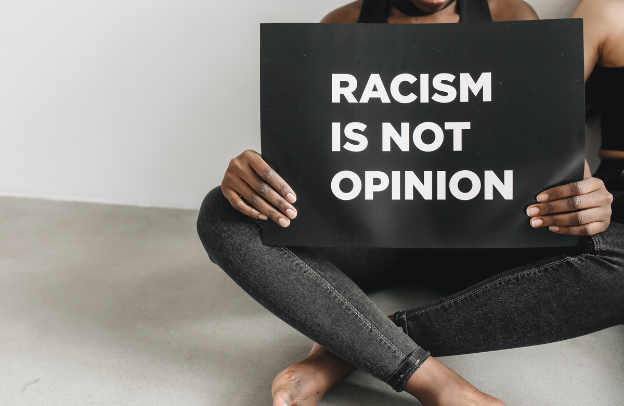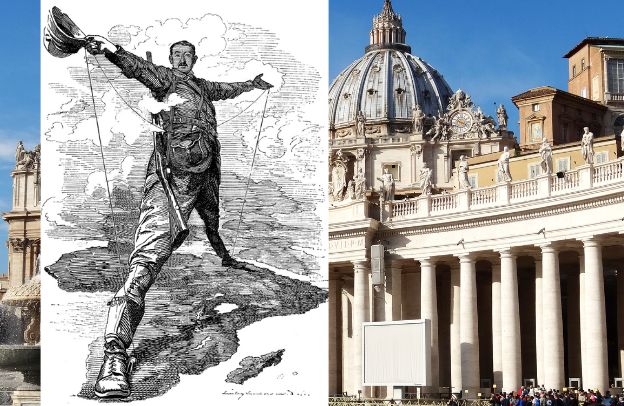In America Before Columbus: Exploring European Racist Stereotypes

This is part four in the series “Racism And Slavery: Reflection On Human Madness by Stefano Anselmo”. See previous publications to learn more.
Want to learn more about storytelling? Start by downloading the first chapter of The Storytelling Mastery.
Here is a list of all the articles in the series – Racism And Slavery: Reflection On Human Madness by Stefano Anselmo:
- Racism And Slavery: Reflection On Human Madness by Stefano Anselmo
- What Racism Requires: Religion And Science Were To Go Hand In Hand
- Racism And Slavery: How The Hamitic Theory Began To Crumble
- In America Before Columbus: Exploring European Racist Stereotypes
- Racism And Slavery: African Crisis Is An Invention Of The West
- Our House Slaves: European Centuries Of Heritage
- Religious Endorsement Of Slavery As A Legitimized Business Both In Islam And Christianity
Why Racist Europeans Created Stereotypic And Fake Stories About Africans
During colonialism, European powers often propagated racist stereotypes and fabricated stories about Africans for several interconnected reasons. Firstly, such stereotypes served to justify the subjugation and exploitation of African peoples.
By depicting Africans as inferior, uncivilized, and inherently prone to violence or laziness, European colonizers could rationalize their actions as a benevolent mission to “civilize” and “educate” the indigenous populations.
These stereotypes helped to uphold the narrative of European superiority and the so-called “White Man’s Burden,” providing a moral justification for the exploitation of African resources and labor.
Secondly, racist stereotypes and fabricated stories were used as tools of control and domination. By portraying Africans as primitive and backward, European colonizers sought to justify their imposition of colonial rule and the suppression of local cultures and identities.
Such narratives also served to divide and conquer indigenous populations, as they fostered mistrust and animosity among different ethnic groups, making it easier for European powers to maintain their grip on power.
Additionally, these stereotypes were disseminated through various mediums such as literature, art, and media, perpetuating harmful stereotypes that continue to impact perceptions of Africans to this day.
The real consequence of these actions on African people
You might think these are bygone events so we should move. Well, the consequences of these hundreds of years of European fabrication of lies have real consequences on the African people even to date.
You might not understand but the truth is that the fabricated stories propagated during colonialism continue to reverberate in African societies today, shaping social, economic, and political dynamics. Here are just the 5 to think about:
- These narratives have contributed to the internalization of inferiority complexes among some Africans, affecting self-perception and confidence.
- Persistent racial prejudices and discrimination against the African people in the diasporas.
- Economic ramifications, including ongoing exploitation of resources and labor, perpetuating cycles of poverty, and hindering sustainable development.
- Political instability stemming from colonial legacies of division and oppression. these continue to fuel conflicts and hinder efforts toward peace and national unity.
- Continued struggle for equality, dignity, and self-determination across the African continent, reflecting the enduring impact of colonial-era stereotypes and narratives.
These are only a few. Now, let’s continue with the series.
Continuation From The Series
Among the ruins of Zimbabwe and its surroundings, Chinese coins from the years between 713 and 742 AD have also been found, some from 845 AD, and in greater quantities, coins in use in China from 1068 to 1086 AD; others between 1131 and 1163 AD.
We know that shortly before 1480, the time of the great voyages of the Portuguese explorers, a Chinese fleet visited Mogadishu, through which part of the exports of the kingdom of Monomotapa passed.
- The Vikings in the 10th century.
- Abubakari II in 1312 departed with an expedition of about 180 ships to explore the ocean beyond. In fact, during his 2nd voyage, the natives told Columbus that black-skinned men had arrived before him. As proof, they gave him lances with yellow metal tips that belonged to these dark-skinned African Muslims. When Columbus returned to Spain, he had them examined, and it was discovered that the metal was 18 parts gold (56.25%), 6 parts silver (18.75%), and 8 parts copper (25%), the same ratio as the metal produced in the African workshops of Guinea.
The City of Blood of the Edo society. 1897: enticed by the large quantity of precious objects, the British destroyed the city-state of Benin to seize it.
The enormous loot consisting of several thousand highly valuable sculptures and artifacts in bronze, ivory, terracotta, and wood were brought to Europe and scattered among museums and private collections.
The British justified their acts of blood by inventing stories of horrifying human sacrifices that allegedly occurred annually in the city. Benin City became known worldwide as the “city of blood,” and the king was denounced as an abominable savage and demon in human form.
All this was spread by the sensationalistic British press, which often used tendentiously retouched images to devalue the culture and society of Benin.
See also The Origin Of Uromi And Esanland, Nigeria (Agba: The Esan God Of War, 1)
However, with the dissemination of the looted artworks, it became increasingly difficult to sustain the image of the “degenerate race” that showed “no signs of civilization,” the pretext with which the country had been destroyed. For this reason, a new “model” capable of resolving the contradiction between grand local art and the alleged barbarism in use was proposed.
It was explained that the artworks belonged to a civilization that had reached its peak many centuries ago, then declined into a wild state, which only the “civilized West” could end. There was also the “scientifically recognized” conviction that none of the inhabitants of the kingdom at that time were capable of producing that type of art, and therefore the artworks became “remnants of a previous and greater civilization.”
In this way, European racist stereotypes were spread, protecting commercial interests, minimizing military misdeeds, and legitimizing colonial plundering. As a result, the image of Africa, then prevalent in the West, remained essentially unchanged.
In the German Ideology, The assertions, even of eminent thinkers, favor the dissemination of the image of the black African as immature and childish; it is the myth of the noble savage: in 1932, Karl Marx and Friedrich Engels in “The German Ideology” launch an attack on the German philosophy of the time represented by Ludwig Feuerbach and other philosophers.
On page 151 of the work, they write: “Negroidism is conceived as ‘the child,’ because Hegel (Philosophy of History, p. 89) says: ‘Africa is the country of childhood of history.'” “In the determination of the African (black) spirit, we must completely renounce the category of universality,” still on page 90, that is, the child and the black person, despite having thoughts, have not yet reached the level of thought.
“In blacks, consciousness has not yet reached a firm objectivity, as for example God, the law, in which man would have the intuition of his own essence”…. “so the knowledge of the absolute is completely lacking.” The black person represents the natural man in a free state.
In the Middle Ages, the philosophers of Patristics and Scholasticism debated whether Blacks and women had souls. Mentioning the topic today is not politically correct, so one is hastily considered racist and reactionary.
In reality, the issue is broader and more complex because it poses a question: “Why did figures of great culture pose such a problem?” Today we live in a formal democracy in which the law consists of various codicils and quibbles, some of which had already been highlighted by Francois Rabelais in his masterpiece “Gargantua and Pantagruel.”
In the meantime, the general ethical situation has greatly deteriorated.
- Why is racism primarily directed towards blacks?
- Why do blacks constitute a problem in every country, including Africa?
- Why, in parallel with the exponential growth of female visibility and power, does society undergo an ethical collapse?
- Why does the majority of the female world always side with blacks and homosexuals?
- Why, despite undeniable feminist achievements, has prostitution and pornography not decreased but greatly increased?
- Why have women in the art world given ample space to the exhibition of the body and explicit sexuality?
All this happens with the complicity of an ignorant and corrupt political class. Questions remain awaiting answers, not obscene slogans, processions, and polemics without constructiveness.
Mithridatization
For almost two centuries, the West has spread distorted information through every possible means, shaping the minds of young people, the future adults, with information inducing the belief (which is what a large part of Westerners still thought) that the disparity between Blacks and Whites stems from “natural” motivations and that the latter are effectively candidates to live in a state of inferiority.
An illustrative example of manipulative information comes from Volume II of the Illustrated Encyclopedia for Children, published around the 1950s, where youngsters found readings that fostered the dissemination and consequent eroticization of preconceived ideologies, stereotypes, and racist prejudices.
One example, among many, is on page 951, in the section dedicated to curiosities, where a heading asks: “Why are inhabitants of extremely hot countries black?” The answer starts from the assumption that man was created white (thus European) and then degenerated into darkness due to climatic adaptation, forming a completely separate race: “Probably originally white, they darkened their skin due to the effect of the sun, and the children of those with darker skin and more tenacious physical resistance to heat and climate propagated and multiplied, forming a completely separate race.”
Once adults and accustomed to the poison slowly and constantly assimilated over the years, these former youths became supporters and sometimes unwitting carriers of today’s institutionalized racism in society. This occurs when there is no explicit attitude suggesting discrimination, but the final result in behaviors is unequivocally racist.
At the root of these behaviors is a culture of racism entrenched in society, even as the same society extols formal commitment to equality. It is today’s society, born from racism, resulting from centuries of discrimination and xenophobic attitudes.
Most people have grown up immersed in this culture, unconsciously absorbing all its negative aspects. Historical and cultural conditions have shaped both our Western perception and that of Africans and Blacks in general.
Furthermore, the caption of Table IV in the encyclopedia “Peoples and Races” conveys a strongly racist message and denies evidence; it is the result of the still dominant scientific racism of those years; Fig. 12.
In Italy, the aftermath of fascist racism certainly did not help improve things. The inferiority of Blacks, seen as a sort of distraction of nature, was part of common thought and scientific thought. In “Epoca,” a prestigious weekly magazine of information and culture dated October 16, 1960, we find no less than 2 extensive articles on the subject.
The first (pages 69/71), more worldly, is dedicated to Henry Belafonte, an American musician and fervent activist for the civil rights of African Americans. Almost as if to punish the audacity of not accepting his “natural” inferior position in society, the subtitle insinuates subtly and without any basis that Belafonte would like to be white and feels humiliated by not being so; a very frequent arrière pensée in the 20th century.
On page 22, however, a title with a very serious tone states: “Let’s not confuse races and racism,” but in the subtitle, it specifies: “The intellectual inferiority of blacks is proven, whites must treat them with justice and charity!
The Role of the Church
In this anthropological debate, the Church played a fundamental role. The proponents of biblical stories about the dispersion of peoples (Babel, Ham, etc.) felt compelled to respond to the challenges of science.
This effort is clearly documented by various publications starting from 1880: from the manuals of the Sulpician F. Vigouroux to his “Dictionary of the Bible” of 1926.
The biblical episode of the Tower of Babel made that of the curse of Ham a decisive episode: the Hamites were punished for Ham’s act of pride, relegated to the farthest lands (farthest from whom or from where is not explained) and more burnt by the sun.
In this context, the distinction between “Hamites” and “Blacks (Hamitic)” becomes explicable by indicating the former as the product of the more recent flow of exiles; that is, born from the hybridization between the sons of Ham and the sons of Shem. More ironically, we could say that they are “Semitized Hamites” or “de-Hamitized Hamites”.
These theories were supported and disseminated by two highly authoritative White Fathers: the French bishop Gorju and the Dutch Van der Burgt, in 1903, as already mentioned to explain the origin of the Tutsis of Burundi and Rwanda.
In 1902 Léon Classe, a future bishop in Rwanda noted that the Batutsi “are splendid men, with fine and regular features, with elements of Aryan and Semitic typology”.
Without going into details, we emphasize that all the literature of the time, supported by legends considered real facts and fanciful etymological adaptations, ended up spreading the idea that the Great Lakes region was a sort of second Ethiopia, a paradise for Hamitic peoples (Caucasoids with dark skin).
The administrators and missionaries who operated in Rwanda and Burundi were steeped in this romantic literature and were seriously convinced of the eastern, Egyptian (the Egyptians had already been caucasized for some time) or Ethiopian and therefore foreign, character of the Batutsi. Governor Pierre Rickmans, in the 1920s-1930s, compared the Batutsi to Ramses II or Sesostri.
See also Arikana Chihombori-Quao: Champion of African Unity, Diaspora Engagement, and Economic Empowerment
One of the effects produced by this ideology was to forget the initial meaning of its definition: the word Hamite was cleansed and freed from its biblical references that inevitably marked its co-genesis with the black race, to be translated, filtered through Arabic, as “reddish-brown”. Common beliefs, described, for example, in the volume of the French canon L. De Lacge (from 1939 and republished in ’59), official historian of Rwanda and master of thought and moral guide of the seminarians of Kabgay.
And as Father François Ménard wrote in 1917, “The Mututsi is a European with black skin”. J.H. Shelke, the English explorer, goes beyond the imaginable and sees in the Watutsi and Wahuma, ancient Christians who have forgotten the biblical tradition: “(…) they were Christians like us, and if the Wahuma had not lost the knowledge of God, they would still be.”
As daring as this idea of the forgotten Christianity of “Hamitic-Tutsi” peoples may seem, it will be taken up at a higher level by the missionary Church in Rwanda: “Originally Monophysites in Abyssinia, it is likely that the Amiti gradually forgot, during their long exodus, the Christian faith by adopting practices and superstitions of the peoples near whom they found themselves living.”
This way, both monotheism (Adam and Eve as parents of Humanity) and racial diversities recognized by official science could peacefully coexist.
Want to learn more about storytelling? Start by downloading the first chapter of The Storytelling Mastery.






